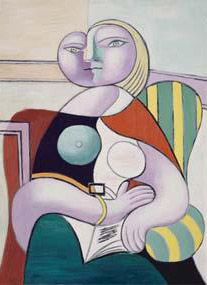 On Tuesday Timothy Anglin Bugard, curator of American art at the de Young, appeared on KQED Radio’s Forum to discuss the Picasso exhibition currently on display at the museum. Afterward, I asked him a few ignorant questions about the show, called Picasso: Masterpieces from the Musée National Picasso, Paris, and about the Master himself.
On Tuesday Timothy Anglin Bugard, curator of American art at the de Young, appeared on KQED Radio’s Forum to discuss the Picasso exhibition currently on display at the museum. Afterward, I asked him a few ignorant questions about the show, called Picasso: Masterpieces from the Musée National Picasso, Paris, and about the Master himself.
Interview: de Young Curator on Picasso Exhibition; Slideshow
The exhibit covers Picasso’s entire career, including iconic masterworks from every period, plus the working drawings for many of the pieces.
Among the iconic works: From Picasso’s Blue Period, La Celestina, a portrait based on a literary character, a madame from a Barcelona brothel. She’s not only a madame, she’s a witch. Picasso was always entranced with the idea of a person who was physically blind but might be a visionary in another way. Picasso himself was famous for his own penetrating gaze, and this paitng is a perfect emblem of that.
Also, Two Women Running on the Beach, from 1922, in his neo-classical period. The painting depicts two women streaking across the beach at full speed. They are sort of maenads who would have these bacchanalian revels and then release all their inhibitions. It’s a moving portrait of movement and dynamism, and in a kinesthetic sense, their limbs are enlarged the way you might feel if you were extending or distorting your body at great speed.
I think Picasso’s name connotes many things to many people. We all bring our preconceptions, but after you work your way through the exhibtion and the dozens of styles and media he embraced and challenged himself with and triumped over, you come away with the sense of this protean artistic force that was able to see the world completely anew and image it in ways like cubism and surrealism that were never seen before.
He changed the ways that not only the average person looks at the world but the way artists look at the world. He granted them permission that art could be everything. It’s sort of art about art, meta-art. Art that can use anything as its subject matter, including found objects. He very famously took objects from the dump and then created artworks out of it. He had the sense of himself as a magician who could metamorphize something out of nothing.
Picasso is already an old master. We think of him as the great pioneer of modernism, and yet his works are already a hundred years old. He’s already a part of the history of art and yet people return to his work again and again. Anyone who’s an artist and loves art is so compelled by the sheer physical presence of his works and you the power of his spirit behind them. And that’s what will keep them in the realm of great art forever.